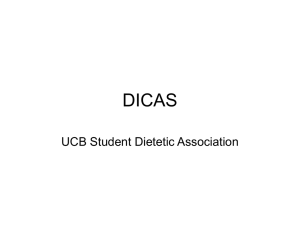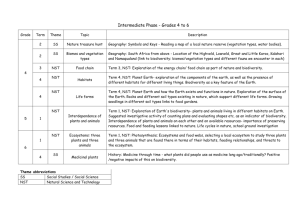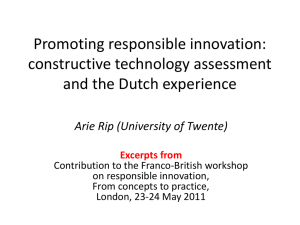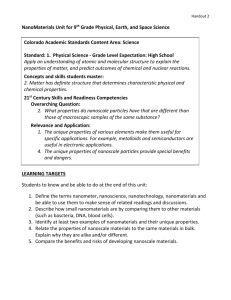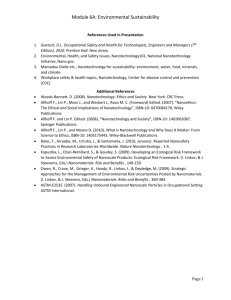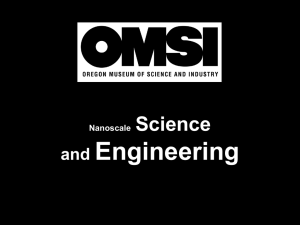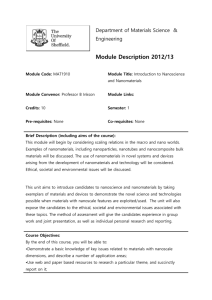An analysis of the educational significance of nanoscience and
advertisement
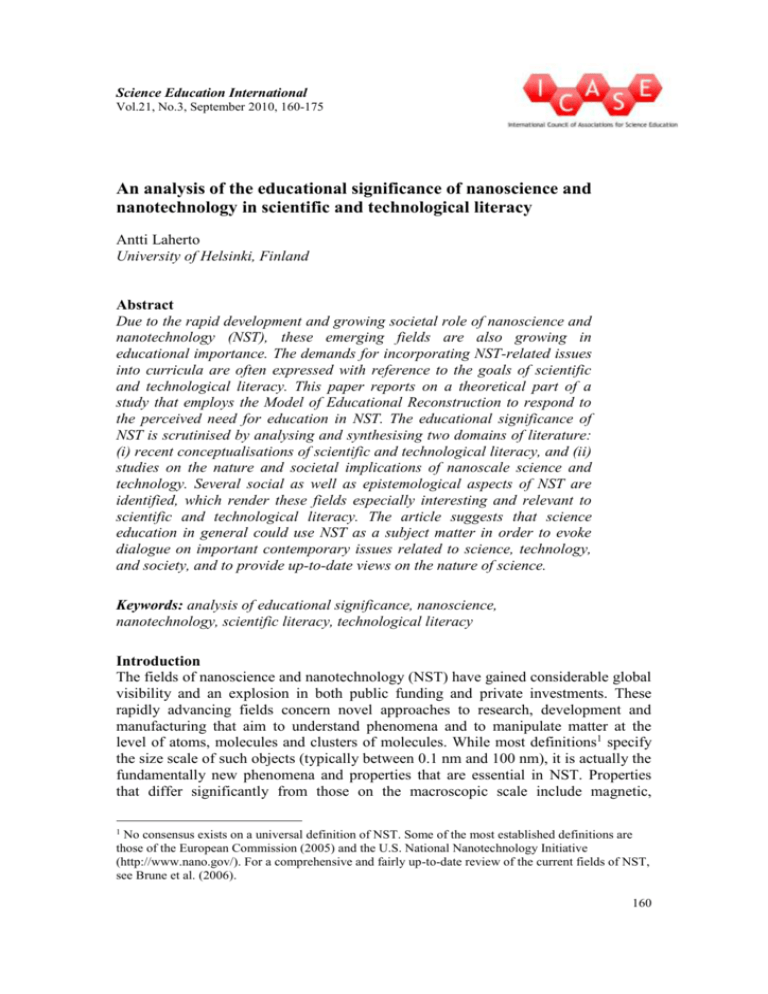
Science Education International Vol.21, No.3, September 2010, 160-175 An analysis of the educational significance of nanoscience and nanotechnology in scientific and technological literacy Antti Laherto University of Helsinki, Finland Abstract Due to the rapid development and growing societal role of nanoscience and nanotechnology (NST), these emerging fields are also growing in educational importance. The demands for incorporating NST-related issues into curricula are often expressed with reference to the goals of scientific and technological literacy. This paper reports on a theoretical part of a study that employs the Model of Educational Reconstruction to respond to the perceived need for education in NST. The educational significance of NST is scrutinised by analysing and synthesising two domains of literature: (i) recent conceptualisations of scientific and technological literacy, and (ii) studies on the nature and societal implications of nanoscale science and technology. Several social as well as epistemological aspects of NST are identified, which render these fields especially interesting and relevant to scientific and technological literacy. The article suggests that science education in general could use NST as a subject matter in order to evoke dialogue on important contemporary issues related to science, technology, and society, and to provide up-to-date views on the nature of science. Keywords: analysis of educational significance, nanoscience, nanotechnology, scientific literacy, technological literacy Introduction The fields of nanoscience and nanotechnology (NST) have gained considerable global visibility and an explosion in both public funding and private investments. These rapidly advancing fields concern novel approaches to research, development and manufacturing that aim to understand phenomena and to manipulate matter at the level of atoms, molecules and clusters of molecules. While most definitions1 specify the size scale of such objects (typically between 0.1 nm and 100 nm), it is actually the fundamentally new phenomena and properties that are essential in NST. Properties that differ significantly from those on the macroscopic scale include magnetic, 1 No consensus exists on a universal definition of NST. Some of the most established definitions are those of the European Commission (2005) and the U.S. National Nanotechnology Initiative (http://www.nano.gov/). For a comprehensive and fairly up-to-date review of the current fields of NST, see Brune et al. (2006). 160 An analysis of the educational significance of nanoscience and nanotechnology in scientific and technological literacy mechanical, electronic, optical, thermodynamic and thermal, as well as the abilities to self assemble and recognise (see Brune et al., 2006). These size-dependent properties have opened the door to a range of applications. During the past decade, the fields of NST have become increasingly associated with important societal, economic, and ethical issues. As a consequence of this development, it has been frequently recommended that education in NST be provided at different levels. These demands have been made from a variety of viewpoints by a variety of advocates, including governments and public administrations, industry and commerce, civic organisations, nanoscientists and engineers, science and technology educators, and social scientists (see e.g. Roco, 2003; Roberts, 2004; European Commission, 2005; 2010; Brune et al., 2006; Healy, 2009). The most common concern is the impending lack of researchers, engineers and other professionals with specialisation in nanoscale issues. In many cases, however, the need for NST education has been expressed with reference to scientific and/or technological literacy (e.g. Sabelli et al., 2005; Zenner & Crone, 2008; Stevens et al., 2009; Stevens et al., 2010), concepts that have remained highly influential in curriculum development projects worldwide (e.g. Laugksch, 2000; Roberts, 2007; Holbrook, 2010). The basic idea in these claims is that all citizens will soon need some kind of “nano-literacy” in order to navigate some of the important science-based issues related to their everyday lives and society. To some extent, these demands have also been answered not only by initiating NST education at the academic level (see comprehensive reviews in Brune et al. 2006; Baraton et al. 2008), but also by launching several projects aimed at incorporating topics of NST into the primary and/or secondary school curriculum (see multiple examples in Sweeney & Seal, 2008). The most wide-ranging and systematic initiatives have been carried out in the U.S. and funded by the National Science Foundation and the National Center for Learning and Teaching in Nanoscale Science and Engineering. These projects include workshops and Delphi studies aimed at clarifying the central elements of NST that should be incorporated into curricula (Sabelli et al. 2005; Stevens et al. 2009; Wansom et al. 2009). In several European countries, novel teaching and learning materials on nanotechnology are currently piloted within the NANOYOU project2 funded by the European Commission. More and more approaches and modules for NST teaching are reported in the international literature on science and engineering education (e.g. Jones et al., 2003; Daly et al., 2007; Sweeney & Seal, 2008; Stevens et al., 2010). Furthermore, in addition to incorporating such subject matters into the formal educational system, demands for NST education have also spawned several informal outreach projects worldwide. These initiatives include educational web-based materials directed at the general public, as well as exhibitions in museums and science centres3. Despite the growing number and quality of learning environments in NST and research related to them, there is still a lack of systematic analysis of the educational meanings of the domain in question, covering the nature of these fields and their 2 The NANOYOU project aims to increase young people's basic understanding of nanotechnologies and to engage them in dialogue about its ethical, legal and social aspects (see http://www.nanoyou.eu/). 3 For specific examples in Europe, see Gyalog (2007); for examples in the U.S., visit the Nanoscale Informal Science Education network at http://www.nisenet.org/. 161 Antti Laherto relationships with society. Consequently, the broad purpose of this paper is to adopt a research-based perspective to address the educational needs stemming from the rapidly developing fields of NST, and to lay some groundwork for curriculum development to meet those needs. The paper presents a part of a larger project that employs the Model of Educational Reconstruction (Duit, Komorek & Wilbers, 1997; Duit, Gropengiesser & Kattman, 2005) for analysing the domain of NST from an educational viewpoint. The partial study reported here belongs to the analytical component of the model. It contributes to an analysis of the educational significance (Duit, 2007) of NST by scrutinising the content structure of its various fields from the perspective of the general goals of science and technology education. Some educationally relevant aspects of NST are pointed out, and reasons for incorporating NST into curricula are discussed. The paper bases its argumentation on a theoretical analysis of the literature on two scientific domains: (i) recent conceptualisations of scientific and technological literacy, and (ii) studies on the nature and societal significance of nanoscale science and technology. The first-mentioned research field is as ample and diverse as the concept of scientific and technological literacy itself (e.g. Shamos, 1995; McEneaney, 2003), whereas the latter domain is still relatively new and tentative. Still, despite the novelty of NST, considerable research on the nature and societal aspects of these fields has already been published (Baird, Nordmann & Schummer, 2004; Brune et al., 2006; Cameron & Mitchell, 2007). These studies have pointed out certain features that can be taken into account when developing innovative science and technology education on the topics in question. The following chapter presents the frame and methodology of the study in detail, whereas the third chapter discusses the concept of scientific and technological literacy, and defines the interpretation employed in this study. Certain key aspects of NST are then analysed with respect to the chosen view of scientific and technological literacy, and lastly, some conclusions are proposed regarding curriculum development. Research frame The study reported here is embedded within the Model of Educational Reconstruction proposed by German science education researchers in the mid-1990s (Duit et al., 1997; Duit et al., 2005). The model was designed to provide a “theoretical framework for studies as to whether it is worthwhile and possible to teach particular areas of science” (Duit, 2007, p. 5). Accordingly, the model has previously served in scrutinising comparatively novel fields of science – fields that are not yet part of the school curriculum. Duit, Komorek & Wilbers (1997), for example, applied the model to the case of chaos theory; Komorek & Duit (2004) continued this application by reconstructing the domain of non-linear systems. On the basis of these previous cases, the model appears to be suitable for analysing also the emerging fields of nanoscience and nanotechnology from an educational perspective. This approach falls within the philosophic tradition of curricular inquiry, which asks whether “children should be taught certain things or in certain ways, based on what we believe are just and appropriate educational goals and means” (Darling-Hammond & Snyder 1992, p. 41). The Model of Educational Reconstruction, associated with the design research tradition, combines analytical and empirical educational research with the practical development of learning environments and teaching-learning sequences. Thus, the 162 An analysis of the educational significance of nanoscience and nanotechnology in scientific and technological literacy model typically involves several studies and a variety of research approaches and methods. The basic idea of the model is that the content structure for instruction cannot be taken directly from science content structure, but must be specially (re)constructed by paying close attention to educational goals as well as to learners’ cognitive and affective perspectives. The Model of Educational Reconstruction consists of three components: 1) analysis of content structure, 2) research on teaching and learning, and 3) design of learning environments (Komorek & Duit, 2004; Duit, 2007). The components are closely interlinked so that results from one component influence the other two components as well. The study reported here deals with only one aspect of an educational reconstruction of NST, analysis of educational significance, which is an integral part of the model’s first component, analysis of content structure. Duit (2007) points out that “content structure” is understood here in a broader sense than usual: educational reconstruction must encompass not only scientific concepts and principles, but also the nature and methodology of the field in question, as well as its relevance to everyday life and society in general. Research methods in this component of the model are mostly hermeneutic-analytical (Duit et al., 2005). Subject matter is clarified and educational significance analysed through content and textual analyses, and by drawing on the philosophy and history of science. All these aspects are analysed from the viewpoint of educational aims and concerns (Duit et al., 1997). Accordingly, this paper scrutinises the educational significance of NST on the basis of the existing literature on the nature and social aspects of the fields, from the critical perspective of science and technology studies (STS). The literature analysed includes a range of philosophical as well as social studies on NST. The reflection is framed by the goals of scientific and technological literacy, further discussed in the following section. Interpretation of scientific and technological literacy in this study Enhancing scientific literacy (SL) is a major educational objective worldwide. The concept has developed into an umbrella term covering virtually everything regarding science education (see e.g. Shamos, 1995; Laugksch, 2000). This ambiguity stems from the diversity of underlying reasons for promoting SL, including various standpoints and benefits at both the personal and societal as well as national and global levels (Sjøberg, 1997; Fensham, 2002; McEneaney, 2003). Many professional scientists and technologists, for example, see promoting SL chiefly as a means to strengthen the public and political support for science and technology (Shamos, 1995; Laugksch, 2000). Researchers generally assume that more scientifically and technologically literate citizens – and politicians – are more apt to support public expenditures on enterprises of science and technology. Another commonly stated reason for enhancing SL, closely related to the one just mentioned, is the need to ensure a steady supply of scientists, engineers and science-related professionals (cf. "Vision I" in Roberts, 2007). Both of these reasons are often reduced to national and economic considerations because of the general idea that advancement in science and innovations in technology form a basis for economic growth (Laugksch, 2000; McEneaney, 2003). Furthermore, debate continues on the implied interpretations of 163 Antti Laherto the word ‘literate’: literate, in its “fundamental sense” (Norris & Phillips, 2003), refers to the ability to read and write, but it can also mean ‘learned’, or ‘competent’, or ‘able to function minimally in society’ (Laugksch, 2000). Since the meanings of SL vary widely depending on these rationales, one must articulate a perspective when applying the concept. This study employs a functional and contextualised interpretation of SL, focusing on citizens’ ability to form opinions and to make reasoned decisions about personal as well as societal issues related to science and technology. Such emphasis also appears in the highly influential PISA definition of SL (OECD, 2007), recent recommendations for European science education policies (Osborne & Dillon, 2008), and “Vision II” for SL proposed by Roberts (2007). From this point of view, SL becomes a prerequisite for participatory democracy. Since science and technology permeate virtually all aspects of society, laypersons must be able to participate intelligently and independently in decisionmaking processes that have a scientific or technological basis (Jenkins, 1997; Laugksch, 2000; Fensham, 2002; McEneaney, 2003). Issues of this kind that receive the greatest public attention are typically those that concern health, energy, natural resources, food, environment, and so forth. Knowledgeable citizens are also likely to be more confident, competent and successful in a society dominated by science and technology. At least some scientific and technological understanding and skills are needed for very practical purposes in everyday life (Laugksch, 2000; cf. Shamos, 1995). This idea of SL, which Jenkins (1997) also refers to as “citizen science”, is congruent with the insights of the STS movement and the Socioscientific Issues (SSI) framework (Zeidler et al., 2005). This line of thought is also closely linked to a few other rationales for SL. Namely, SL is often regarded as a contributor to sustainable development (Holbrook, 2009), since a more scientifically and technologically literate population is more likely to make environmentally and ethically wiser and more responsible decisions. As Bybee (2010) puts it, science and technology education must be part of the response to “the grand challenges for citizens and societies”, such as climate change or health care. For some advocates, furthering SL is also a means of redressing some social or economic injustices and imbalances related to science and technology (Jenkins, 1997). The conception of SL in this study (the ability to participate in socio-scientific decisions) shifts the requirements associated with it towards a multidimensional form that commonly includes not only scientific content knowledge (terminology, facts and concepts), but also – and most importantly – procedural skills (manipulative and intellectual), dispositions (attitudes and behaviours), and an understanding of relationships between science, technology, and society, as well as the history and nature of science (Wenning, 2006; Roberts, 2007). Above all, SL is considered a functional ability, the ability to use scientific knowledge in real-life situations (cf. Holbrook, 2010). Thus, the knowledge required must be relevant to citizens and situated in meaningful contexts (Jenkins, 1997; Zeidler et al., 2005; Roberts, 2007). Accordingly, the PISA definition distinguishes three contexts of SL – personal, social and global – in which students’ functional use of knowledge is examined. The competencies central to this interpretation of SL are identifying scientific issues, explaining phenomena scientifically, and using scientific evidence (OECD, 2007). These competencies require not only knowledge of the natural world, but also of science itself, including its nature and processes. Compared to the definitions of SL in 164 An analysis of the educational significance of nanoscience and nanotechnology in scientific and technological literacy the earlier PISA frameworks, the 2006 framework accentuates students’ attitudes toward science, knowledge about science and an understanding of the relationship between science and technology as integral parts of SL (OECD, 2007). These emphases are also evident in other recent views of science education for SL (Osborne et al., 2003; Wenning, 2006; Roberts, 2007; Bybee, 2010; Holbrook, 2010). Accordingly, the study presented in this paper also considers an understanding of the nature of science as well as of the interrelationships between science, technology, and society to be central components of scientific literacy. While the concept of SL has remained ambiguous, definitions of technological literacy are even more diverse and tentative – despite some large-scale efforts to solidify the concept, such as the initiative by the International Technology Education Association (ITEA, 2000). This tentativeness exists partly because the field of technology education is much younger than that of science education. Moreover, since conceptions of technological knowledge are highly fragmented and hardly any consensus exists on the nature of technology itself, defining technological literacy and imbuing it with pedagogical substance has been a troublesome task (Jenkins, 1997). However, in recent decades, the unified concept of scientific and technological literacy (STL) has also seen increasing use (Holbrook, 2010). Furthermore, many scholars tend to see that scientific literacy alone involves not only science, but technology as well. In his critique of the scientific literacy movement, Shamos (1995) argues that the "socio-scientific issues" discussed in reference to SL are, in fact, based primarily on technology. A grasp of technology and its relations to society should thus be considered the cornerstone of scientific literacy as well (for similar views, see Sjøberg, 1997; Bybee, 2010; Holbrook, 2010). In the same way, Roberts's (2007) "Vision II", which also emphasises citizens' ability to deal with science-based societal issues, implicitly couples understanding of technology with scientific literacy. Accordingly, functional scientific literacy in this study is also considered to include an understanding of technology and its relationship to society; to highlight this unified view, this study employs the concept of scientific and technological literacy instead of SL alone. Also the context of the study – nanoscience and nanotechnology – provides a reason for this conception of STL. Namely, scholars have argued that the general convergence of science and technology (discussed in the following section) is especially strong in the emerging new fields of research and development. In the case of NST in particular, it may prove both unnecessary and difficult to make a distinction between nanoscience and nanotechnology (Nordmann, 2004; Schiemann, 2004), and consequently, between scientific and technological literacy regarding these topics. Educationally significant features of nanoscience and nanotechnology The conception of STL outlined above emphasises knowledge about science more than knowledge of science (cf. OECD, 2007). From this viewpoint, the features of nanoscience and nanotechnology that are relevant to the general public mostly concern the nature of the fields and their societal implications (cf. Roberts’s (2007) “Vision II”). This section, therefore, focuses on analysing the content matter on the basis of the literature that views NST from the critical perspective of Science and 165 Antti Laherto Technology Studies (STS)4. During past decade, a number of publications have employed historical, analytical and ethical approaches in the study of these emerging fields. These philosophical and sociological points of view are relevant and noteworthy in educational reconstruction (cf. Duit, 2007) from the perspective of scientific and technological literacy. Societal implications of NST Although the societal implications of nanotechnology are presently rather modest, the prospects for future implications are significant. Public interests as well as general concerns focus largely on the pros and cons of nanotechnology with regard to society, the environment and health (Macoubrie, 2006). It is commonly acknowledged that the products of nanotechnology can be employed in favour of the environment. These benefits are mostly expected to emerge from novel types of pollutant filters and more efficient energy production and storage technologies (Brune et al., 2006; Hunt & Mehta, 2006; Cameron & Mitchell, 2007). On the other hand, the main risk of nanotechnology concerns the general lack of knowledge about the health and environmental impacts of releasing nanoparticles into the environment (Hunt & Mehta, 2006; Cameron & Mitchell, 2007). Furthermore, a few other ethical issues related to NST also raise concerns (Moor & Weckert, 2004; Berne, 2008). Social scientists have suggested that ethical reflection on the various prospects of NST is needed, as is open societal discourse weighing the benefits and risks (e.g. Glimell, 2004; Schwarz, 2004). Some scholars have even postulated the need for a new sub-discipline, specific “nano-ethics” (Khushf, 2004; Moor & Weckert, 2004), in order to address the unprecedented ethical questions that nanotechnology raises. Still, published papers that carry out ethical reflection on NST are rather tentative by nature; a systematic analysis has yet to appear (see Moor & Weckert, 2004). For the most part, the current discussion of the ethical aspects of the field either focuses on some remote, revolutionary aspects or treats nanotechnology as a whole rather than examines the impacts of concrete and individual applications (Brune et al. 2006, p. 399-406). The development of risk management strategies has led to regulations in different fields in order to prevent negative impacts on health and the environment. In addition, the precautionary principle and its consequences regarding many fields of NST have recently come under debate (Roberts, 2004; Hunt & Mehta, 2006). Because of all these concerns about the current stage of development of nanotechnologies, several scholars have highlighted the need to enable citizens to make intelligent and independent decisions about nanoscience-related societal issues (e.g. Roberts, 2004; Sabelli et al., 2005; Zenner & Crone, 2008). Furthermore, some social scientists have argued that the matter of participatory democracy discussed in the previous section is especially problematic in the case of NST (Lenhard, 2004; Schiemann, 2004; Brune et al., 2006). This is due to the fact that nanoscale phenomena can be accessed only with highly sophisticated instruments and a great deal of expertise in interpreting the data before they can be presented to the public or to politicians or regulatory officials, for example. And even then, the information is 4 For an alternative approach to analysing and synthesising the content matter of NST for instruction, which focuses on conceptual content knowledge, see Stevens et al. (2009). 166 An analysis of the educational significance of nanoscience and nanotechnology in scientific and technological literacy meaningful only within the framework of certain theories, models and methods that are very complex and difficult for non-scientists to understand. For this reason, concerns arise about supervision and public participation in decision-making processes (Glimell, 2004; Roberts, 2004). Moreover, since the prospects of nanotechnology involve both benefits for and risks to the environment and health, the need for NST education has also been discussed with reference to sustainable development (Schwarz, 2004; Berne, 2008). It is worth noting that nanotechnology is likely to play an increasingly important role in potential improvements as well as risks regarding all of the “grand challenges for citizens and societies”5 listed by Bybee (2010, see also Holbrook, 2009). A public understanding of NST is needed in order to deal with these decisions in a balanced and responsible manner. Moreover, social scientists have addressed the question of how the opportunities and risks of nanotechnology will be distributed globally (Moor & Weckert, 2004; Roberts, 2004), for new technologies generally tend to increase existing inequalities of distribution. On the other hand, many expect developing countries in particular to benefit from nanotechnology in the long term (Brune et al., 2006). The debate on NST, especially in the U.S., has been somewhat polarised by proponents and opponents, and thereby dominated by speculative visions. Many fears and concerns regarding nanotechnology are related to formidable scenarios such as that of the “gray goo” (Moor & Weckert, 2004). In the meantime, positive visions widely serve to increase public awareness and interest in NST, to motivate young people to study and to choose careers in related fields, and to generate funding by enhancing public acceptance and political support (Berube, 2004; Glimell, 2004; Hessenbruch, 2004). However, excessive use of scientific visions in public debate can result in serious problems of communication between science and society (Brune et al., 2006). When communicating futuristic visions, the uncertain and partly unscientific nature of them should therefore be explicitly pointed out in order to foster the intelligent and individual STL outlined in the previous section. Philosophical considerations about NST In addition to the above-discussed societal implications, an understanding the nature of science – including epistemological issues – is also a key element of the chosen notion of STL (cf. Wenning, 2006; Roberts, 2007; Holbrook, 2010). Thus, some special features in the processes of NST should be addressed in order to represent the nature of the fields properly. Due to the novelty of NST, no well-established philosophy of the field yet exists; the number and consistency of publications is still lower than that of the philosophical literature on the mature disciplines. Some scholarly writings have already been published, however, and several philosophically interesting aspects of nanoscience have been identified. Some scholars have even suggested that NST be viewed as an epistemic revolution or a paradigm change (cf. 5 These challenges include climate change, public health, energy efficiency, environmental quality, resource use, natural hazards and national security, among others (Bybee, 2010). Potential pros and cons of nanotechnology specifically concern the fields related to these challenges (see Brune et al., 2006; Hunt & Mehta, 2006; Cameron & Mitchell, 2007). 167 Antti Laherto Khushf, 2004; Schmidt, 2004; Brune et al., 2006). In any case, philosophical considerations of these fields give rise to many issues of educational relevance. To begin with, the interdisciplinary nature of NST has raised epistemological interest. Many fields of NST clearly link two or more of the traditional disciplines or fields of research, mostly physics, chemistry, biology, material science, medicine and engineering6. Many recent writings on modern scientific and technological literacy have emphasised such interdisciplinarity (see e.g. Roberts, 2007). Interdisciplinary research in NST is based on two ideas that provide common ground for researchers from different fields: the shared size scale of objects and shared technological visions (cf. Schummer, 2004). Many expectations rest on this notion of interdisciplinarity, which has even been proposed as the deciding factor in the progress of NST (e.g. Sabelli et al., 2005; Brune et al., 2006). The idea that forthcoming scientific and technological breakthroughs will most likely occur at the intersections of traditional scientific disciplines is generally accepted, and synergetic effects are believed to give rise to innovative research. Reports concerning nanoscale research frequently highlight the necessity of interdisciplinarity (cf. Schummer, 2004). Some have also argued that interdisciplinarity is central to the alleged novelty of NST; because chemists, physicists, biochemists and cell biologists have been studying the “nanoscale” (the atomic and molecular scales) for centuries, it may be just the interdisciplinary approach that makes NST new (see e.g. Sabelli et al., 2005). Furthermore, NST has been associated with the idea of reductionism of the natural sciences (Khushf, 2004; Schmidt, 2004); i.e. the scientific ambition aims not only to link quantum mechanics, solid-state physics, inorganic chemistry and molecular biology, but to unify them as well – at least partially, at the nanoscale. However, doubts also remain about the true state of interdisciplinarity in NST (Schummer, 2004). The educational implications of NST’s multi- or interdisciplinary character are further discussed elsewhere (Laherto, 2010). Philosophers have also pointed out the interesting relationship between nanoscience and nanotechnology. It has been suggested that the traditional, predominant way of thinking, which considers science and technology (or the natural and the engineering sciences) to be fundamentally different enterprises in the sense of purpose and function, fails in the context of NST (Brune et al., 2006). Besides that nanoscience research focuses on the use of various instruments and equipment, the objects under research are artificial and not natural. The field deals with artificially produced situations that depend on human actions and technical purposes. Observations and factual “discoveries” are made only in relation to the states or properties of these artificial objects or events; they do not relate directly to natural entities. Several scholars therefore argue that no clear distinction exists between understanding nature and modifying it (Schiemann, 2004; Schmidt, 2004); Brune et al. (2006) stress that the inclinations to think of natural “nano objects” should be considered suspicious. These features, however, are not exclusive to nanoscience – rather, this merging of science and technology has always existed. This matter has recently been discussed using the concept of “technoscience” (Nordmann, 2004). Anyhow, this convergence 6 An example of such fields is research on the steric effects of cell membranes, where chemists, biologists and physicists share overlapping research interests and approaches that complement each other, and where scientists from different fields also share the same novel instruments to observe the phenomena in question. 168 An analysis of the educational significance of nanoscience and nanotechnology in scientific and technological literacy of science and technology is emphasised and accelerated in the case of NST (Schiemann, 2004; Tala, 2010) and is, therefore, a noteworthy feature of these fields. It also has clear educational implications (cf. Tala, 2009), since understanding the nature of science plays a vital role in being scientifically and technologically literate (cf. Osborne et al., 2003; Roberts, 2007). Another epistemological feature of NST that is also of educational relevance is the central role of modelling and imaging. Brune et al. (2006, p. 53-57) argue that the discourse on NST is replete with apparent confusion of models with descriptions of reality. Nanoscientists tend to use their conceptions of models in similar and straightforward ways as empirical descriptions are commonly used in everyday contexts, without emphasising that these conceptions are relevant only in the framework of certain theories, models, methodological decisions and purposes (Lenhard, 2004). Consequently, models are confused with what is being modelled. Such confusion is also of great concern in NST because of the extensive use of images in representing nanoscale objects and phenomena. The common conception of nanoscience “making atoms visible” is alleged to be problematic (Pitt, 2004), since the microscopy used in nanoscale research is epistemologically not an outright continuation of instruments such as the telescope or light microscope. The scanning force microscope, the atomic force microscope and the scanning tunneling microscope simply do not portray the visible properties of an object in the sense of geometrical similarity and realistic depiction of colors. Rather, these techniques are methods of producing artefacts that are the results of purposeful human action and tell more about the tool of observation than about the objects under observation. They serve certain theoretical models, but do not generate an empirical database in the same sense as telescopy and light microscopy do (Lenhard, 2004; Pitt, 2004; Brune et al., 2006, p. 54-57). Conclusions This paper presents the first phase of an educational reconstruction of the fields of nanoscience and nanotechnology. The broader project involves analytical studies of the subject matter, empirical studies of learners’ perspectives, as well as the development of a learning environment that enhances scientific and technological literacy in the context of NST (cf. Duit et al., 1997; Duit, 2007). The partial study reported here focused on the analytical component of the Model of Educational Reconstruction. The purpose was to theoretically analyse the educational significance of NST by drawing on the nature and implications of those fields. On the basis of the literature analysis carried out in this paper, nanoscience and nanotechnology have several epistemological as well as societal features that make these emerging fields especially interesting and relevant with respect to scientific and technological literacy. In the near future, we will likely have to make more and more decisions concerning NST, both at the personal level as consumers, as well as at the societal level, about the future paths of NST that may substantially affect society. Prospects of nanotechnology involve both benefits and risks to society, the environment and public health. Furthermore, NST may also play a major role in responding to the “grand challenges for citizens and societies” (Bybee, 2010). While the public discussion catalysed by several interest groups tends to be somewhat target-oriented and polarised, realistic and unbiased information on the implications 169 Antti Laherto of nanotechnology is still lacking (cf. Berube, 2004; Glimell, 2004; Roberts, 2004). Consequently, citizens need to be able to deal with these issues in an informed, responsible and independent manner. Science education should stimulate debate on interrelationships between science, technology, and society regarding these important contemporary issues in order to prepare students for such decision-making. Achieving this level of “nano-literacy” is challenging, however, because of the above-discussed complexity of the subject matter and the related communicational challenges. This paper argues that scientific and technological literacy in the context of NST (i.e. the ability to feel comfortable and competent with nanoscientific and technological matters and artefacts, to follow media discussions of related topics, to form opinions on social and ethical issues related to these fields, etc.) requires an understanding of the nature of NST as well as its social dimensions. On the basis of the content analysis, some special features in the processes of NST should be addressed in education in order to represent the nature of the fields properly. These features involve the interdisciplinary character of the fields in question, the entwined relationship between nanoscience and nanotechnology, and the interplay between empirical and theoretical research with distinctive roles of modelling, simulations and imaging. Indeed, science education in general could use NST as subject matters in order to provide more up-to-date views of the nature of science. Moreover, since NST has generated broad public interest and media attention, addressing these topics in school may also contribute to scientific and technological literacy indirectly by motivating young people to study related disciplines in general. The decline of interest in science studies is chiefly due to the disconnect between school science and students’ preoccupations, and also the absence of modern sciences in curricula (Osborne, 2007). Thus, emerging fields such as NST are also noteworthy with respect to the motivational factors that drive scientific and technological literacy (cf. OECD, 2007). However, this paper also points out some educational challenges that must be taken into account when proceeding with the educational reconstruction of NST. The sophistication of the concepts of NST easily leads to superficiality in instruction and the risk of misrepresenting the content matter. Furthermore, the simplified use of images and other visual models can mislead learners into false models of direct sense perception and epistemological misunderstandings. Despite these challenges, discussing the emerging fields of NST in science education appears to be a fruitful way of enhancing up-to-date scientific and technological literacy. NST clearly represents all the key features of ‘postmodern science’ that, according to Hurd (1994), should be better addressed in schools to modernise the science curriculum and to “prepare new minds for a new age”. References Baird, D., Nordmann, A. & Schummer, J. (Eds.) (2004). Discovering the nanoscale. Amsterdam: IOS Press. Baraton, M., Monk, R. & Tomellini, R. (2008). European activities in nanoscience education and training. In A. E. Sweeney & S. Seal (Eds.), Nanoscale science and 170 An analysis of the educational significance of nanoscience and nanotechnology in scientific and technological literacy engineering education (pp. 459-471). Stevenson Ranch, CA: American Scientific Publishers. Berne, R. (2008). Content and pedagogy for ethics education in nanoscale science and technology development. In A. E. Sweeney & S. Seal (Eds.), Nanoscale science and engineering education (pp. 547-566). Stevenson Ranch, CA: American Scientific Publishers. Berube, D. (2004). The rhetoric of nanotechnology. In D. Baird, A. Nordmann & J. Schummer (Eds.), Discovering the nanoscale (pp. 173-192). Amsterdam: IOS Press. Brune, H., Ernst, H., Grunwald, A., Grünwald, W., Hofmann, H., Krug, H., et al. (2006). Nanotechnology. Assessment and perspectives. Berlin Heidelberg: Springer. Bybee, R. (2010). Science and technology education: Grand challenges and significant innovations. Paper presented in ICASE World Conference on science and technology education, June 28th-July 2nd 2010, Tartu, Estonia. Cameron, N. & Mitchell, M. (2007). Nanoscale: Issues and perpectives for the nano century. Hoboken, NJ: John Wiley & Sons. Daly, S., Hutchinson, K. & Bryan, L. (2007). Incorporating nanoscale science and engineering concepts into middle and high school curricula. Proceedings of the Annual Conference of the American Society for Engineering Education, June 24th 27th, Honolulu, Hawaii. Darling-Hammond, L. & Snyder, J. (1992). Curriculum studies and the traditions of inquiry: The scientific tradition. In P. W. Jackson (Ed.), Handbook of research on curriculum: A project of the American Educational Research Association (pp. 4178). New York: Macmillan. Duit, R. (2007). Science education research internationally: Conceptions, research methods, domains of research. Eurasia Journal of Mathematics, Science & Technology Education, 3(1), 3-15. Duit, R., Gropengiesser, H. & Kattman, U. (2005). Towards science education research that is relevant for improving practice: The model of educational reconstruction. In H. Fischer (Ed.), Developing standards in research on science education. London: Taylor & Francis. Duit, R., Komorek, M. & Wilbers, J. (1997). Studies on educational reconstruction of chaos theory. Research in Science Education, 27(3), 339-357. European Commission (2005). Nanosciences and nanotechnologies: An action plan for Europe 2005-2009. Belgium: European Communities. 171 Antti Laherto European Commission (2010). Report on the European Commission's public online consultation: Towards a strategic nanotechnology action plan (SNAP) 2010-2015. Belgium: European Communities. Fensham, P. (2002). Time to change drivers for scientific literacy. Canadian Journal of Science, Mathematics, and Technology Education, 2, 9-24. Glimell, H. (2004). Grand visions and lilliput politics: Staging the exploration of the ‘Endless frontier’. In D. Baird, A. Nordmann & J. Schummer (Eds.), Discovering the nanoscale (pp. 231-246). Amsterdam: IOS Press. Gyalog, T. (2007). Nanoscience education in Europe. Europhysicsnews, 38(1), 13-15. Healy, N. (2009). Why nano education? Journal of Nano Education, 1(1), 6-7. Hessenbruch, A. (2004). Nanotechnology and the negotiation of novelty. In D. Baird, A. Nordmann & J. Schummer (Eds.), Discovering the nanoscale (pp. 135-144). Amsterdam: IOS Press. Holbrook, J. (2009). Meeting challenges to sustainable development through science and technology education. Science Education International, 20(1/2), 44-59. Holbrook, J. (2010). Education through science as a motivational innovation for science education for all. Science Education International, 21(2), 80-91. Hunt, G. & Mehta, M. (Eds.) (2006). Nanotechnology: Risk, ethics and law. London: Earthscan. Hurd, P. (1994). New minds for a new age: Prologue to modernizing the science curriculum. Science Education, 78(1), 103-116. ITEA (2000). Standards for technological literacy: Content for the study of technology. Reston, VA: International Technology Education Association. Jenkins, E. (1997). Scientific and technological literacy for citizenship: What can we learn from the research and other evidence? In S. Sjøberg & E. Kallerud (Eds.), Science, technology and citizenship. The public understanding of science and technology in science education and research policy. Norwegian Institute for Studies in Research and Higher Education, Report No. 7/1997. Jones, G., Andre, T., Superfine, R. & Taylor, R. (2003). Learning at the nanoscale: The impact of students’ use of remote microscopy on concepts of viruses, scale, and microscopy. Journal of Research in Science Teaching, 40(3), 303-322. Khushf, G. (2004). A hierarchical architecture for nano-scale science and technology: Taking stock of the claims about science made by advocates of NBIC convergence. In D. Baird, A. Nordmann & J. Schummer (Eds.), Discovering the nanoscale (pp. 2134). Amsterdam: IOS Press. 172 An analysis of the educational significance of nanoscience and nanotechnology in scientific and technological literacy Komorek, M. & Duit, R. (2004). The teaching experiment as a powerful method to develop and evaluate teaching and learning sequences in the domain of non-linear systems. International Journal of Science Education, 26(5), 619-633. Laherto, A. (2010). Interdisciplinary aspects of nanoscience and nanotechnology for informal education. In M.F. Taşar & G. Çakmakcı (Eds.), Contemporary science education research: teaching (pp. 105-111). Ankara, Turkey: Pegem Akademi. Laugksch, R. C. (2000). Scientific literacy: A conceptual overview. Science Education, 84(1), 71-94. Lenhard, J. (2004). Nanoscience and the janus-faced character of simulations. In D. Baird, A. Nordmann & J. Schummer (Eds.), Discovering the nanoscale (pp. 93-100). Amsterdam: IOS Press. Macoubrie, J. (2006). Nanotechnology: Public concerns, reasoning and trust in government. Public Understanding of Science, 15(2), 221-241. McEneaney, E. H. (2003). The worldwide cachet of scientific literacy. Comparative Education Review, 47(2), 217-237. Moor, J. & Weckert, J. (2004). Nanoethics: Assessing the nanoscale from an ethical point of view. In D. Baird, A. Nordmann & J. Schummer (Eds.), Discovering the nanoscale (pp. 301-310). Amsterdam: IOS Press. Nordmann, A. (2004). Molecular disjunctions: Staking claims at the nanoscale. In D. Baird, A. Nordmann & J. Schummer (Eds.), Discovering the nanoscale (pp. 51-62). Amsterdam: IOS Press. Norris, S. & Phillips, L. (2003). How literacy in its fundamental sense is central to scientific literacy. Science Education, 87(2), 224-240. OECD (2007). Assessing scientific, reading and mathematical literacy: A framework for PISA 2006. Paris: OECD Publications. Osborne, J. (2007). Engaging young people with science: Thoughts about future direction of science education. In C. Linder, L. Östman & P. Wickman (Eds.), Promoting scientific literacy: Science education research in transaction (pp. 105112). Uppsala, Sweden: Geotryckeriet. Osborne, J. & Dillon, J. (2008). Science education in Europe: Critical reflections. A report to the Nuffield Foundation. London: The Nuffield Foundation. Osborne, J., Collins, S., Ratcliffe, M., Millar, R. & Duschl, R. (2003). What “ideas about-science” should be taught in school science? A delphi study of the expert community. Journal of Research in Science Teaching, 40(7), 692-720. 173 Antti Laherto Pitt, J. (2004). The epistomology of the very small. In D. Baird, A. Nordmann & J. Schummer (Eds.), Discovering the nanoscale (pp. 157-164). Amsterdam: IOS Press. Roberts, D. (2007). Scientific literacy/Science literacy. In S. K. Abell, & N. G. Lederman (Eds.), Handbook of research on science education (pp. 729-780). Mahwah, NJ: Lawrence Erlbaum Associates. Roberts, J. (2004). Deciding the future of nanotechnologies: Legal perspectives on issues of democracy and technology. In D. Baird, A. Nordmann & J. Schummer (Eds.), Discovering the nanoscale (pp. 247-256). Amsterdam: IOS Press. Roco, M. (2003). Converging science and technology at the nanoscale: Opportunities for education and training. Nature Biotechnology, 21(10), 1247-1249. Sabelli, N., Schank, P., Rosenquist, A., Stanford, T., Patton, C., Cormia, R., et al. (2005). Report of the workshop on science and technology education at the nanoscale. Draft, October. Technical Report. Menlo Park, CA: SRI International. Schiemann, G. (2004). Dissolution of the nature-technology dichotomy? Perspectives on nanotechnology from an everyday understanding of nature. In D. Baird, A. Nordmann & J. Schummer (Eds.), Discovering the nanoscale (pp. 209-215). Amsterdam: IOS Press. Schmidt, J. (2004). Unbounded technologies: Working through the technological reductionism of nanotechnology. In D. Baird, A. Nordmann & J. Schummer (Eds.), Discovering the nanoscale (pp. 35-50). Amsterdam: IOS Press. Schummer, J. (2004). Interdisciplinary issues in nanoscale research. In D. Baird, A. Nordmann & J. Schummer (Eds.), Discovering the nanoscale (pp. 9-20). Amsterdam: IOS Press. Schwarz, A. (2004). Shrinking the ‘ecological footprint’ with NanoTechnoScience. In D. Baird, A. Nordmann & J. Schummer (Eds.), Discovering the nanoscale (pp. 203 208). Amsterdam: IOS Press. Shamos, M. H. (1995). The myth of scientific literacy. New Brunswick, NJ: Rutgers University Press. Sjøberg, S. (1997). Scientific literacy and school science – arguments and second thoughts. In S. Sjøberg & E. Kallerud (Eds.), Science, technology and citizenship (pp. 9-28). Oslo, Norway: NIFU. Stevens, S., Delgado, C. & Krajcik, J. (2010). Developing a hypothetical multi dimensional learning progression for the nature of matter. Journal of Research in Science Teaching, 47(6), 687-715. Stevens, S., Sutherland, L. & Krajcik, J. (2009). The big ideas of nanoscale science and engineering. Arlington, VA: NSTA Press. 174 An analysis of the educational significance of nanoscience and nanotechnology in scientific and technological literacy Sweeney, A. E. & Seal, S. (Eds.) (2008). Nanoscale science and engineering education. Stevenson Ranch, CA: American Scientific Publishers. Tala, S. (2009). Unified view of science and technology for education: technoscience and technoscience education. Science & Education, 18(3-4), 275-298. Tala, S. (2010). Enculturation into technoscience: Analysis of the views of novices and experts on modelling and learning in nanophysics. Science & Education. Online first: 06 July 2010. DOI: 10.1007/s11191-010-9277-4. Wansom, S., Mason, T., Hersam, M., Drane, D., Light, G., Cormia, R., et al. (2009). A rubric for post-secondary degree programs in nanoscience and nanotechnology. International Journal of Engineering Education, 25(3), 615-627. Wenning, C. (2006). Assessing nature-of-science literacy as one component of scientific literacy. Journal of Physics Teacher Education Online, 3(4), 3-14. Zeidler, D. L., Sadler, T. D., Simmons, M. L. & Howes, E. V. (2005). Beyond STS: A research-based framework for socioscientific issues education. Science Education, 89(3), 357-377. Zenner, G. & Crone, W. (2008). Introducing nanotechnology and society issues into the classroom. In A. E. Sweeney, & S. Seal (Eds.), Nanoscale science and engineering education (pp. 622-647). Stevenson Ranch, CA: American Scientific Publishers. 175
